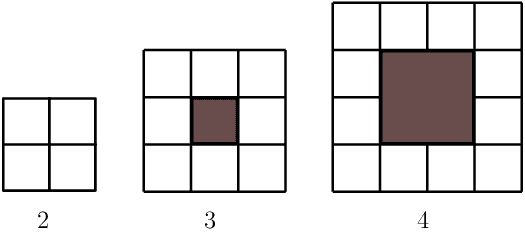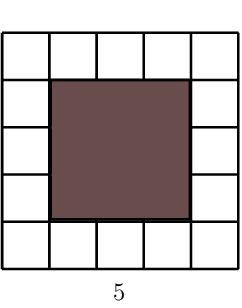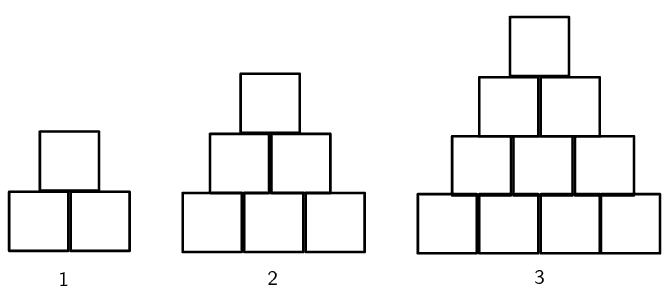Find the first five terms of the quadratic sequence defined by:
\({T}_{n}={n}^{2}+2n+1\)End of chapter exercises
|
Previous
3.3 Summary
|
Next
4.1 Revision
|
End of chapter exercises
Determine whether each of the following sequences is:
- a linear sequence,
- a quadratic sequence,
- or neither.
\(6;9;14;21;30;...\)
Quadratic sequence
\(1;7;17;31;49;...\)
Quadratic sequence
\(8;17;32;53;80;...\)
Quadratic sequence
\(9;26;51;84;125;...\)
Quadratic sequence
\(2;20;50;92;146;...\)
Quadratic sequence
\(5;19;41;71;109;...\)
Quadratic sequence
\(2;6;10;14;18;...\)
Linear sequence
\(3;9;15;21;27;...\)
Linear sequence
\(1;\text{2,5};5;\text{8,5};13;...\)
Quadratic sequence
\(10;24;44;70;102;...\)
Quadratic sequence
\(2\frac{1}{2}; 6; 10\frac{1}{2}; 16; 22\frac{1}{2}; \ldots\)
Quadratic sequence
\(3p^2; 6p^2; 9p^2; 12p^2; 15p^2; \ldots\)
Linear sequence
\(2k; 8k; 18k; 32k; 50k; \ldots\)
Quadratic sequence
Given the pattern: \(16; x; 46; \ldots\), determine the value of \(x\) if the pattern is linear.
Given \(T_n = 2n^2\), for which value of \(n\) does \(T_n = 242\)?
Given \({T}_{n}=3{n}^{2}\), find \({T}_{11}\).
Given \(T_n = n^2+4\), for which value of \(n\) does \(T_n = 85\)?
Given \({T}_{n}=4{n}^{2}+3n-1\), find \({T}_{5}\).
Given \(T_n = \dfrac{3}{2}n^2\), for which value of \(n\) does \(T_n = 96\)?
For each of the following patterns, determine:
- the next term in the pattern,
- and the general term,
- the tenth term in the pattern.
\(3; 7; 11; 15; \ldots\)
\(17; 12; 7; 2; \ldots\)
\(\frac{1}{2}; 1; 1\frac{1}{2}; 2; \ldots\)
\(a; a+b; a+2b; a+3b; \ldots\)
\(1; -1; -3; -5; \ldots\)
For each of the following sequences, find the equation for the general term and then use the equation to find \({T}_{100}\).
\(4;7;12;19;28;...\)

\(2;8;14;20;26;...\)
\(7;13;23;37;55;...\)

\(5;14;29;50;77;...\)

Given: \(T_n = 3n-1\)
Write down the first five terms of the sequence.
What do you notice about the difference between any two consecutive terms?
Will this always be the case for a linear sequence?
Given the following sequence: \(-15; -11; -7; \ldots ; 173\)
Determine the equation for the general term.
Calculate how many terms there are in the sequence.
Given \(3; 7; 13; 21; 31; \ldots\)
Thabang determines that the general term is \(T_n = 4n - 1\). Is he correct? Explain.
Thabang's general term \(T_n = 4n - 1\) describes a linear sequence and this is a quadratic sequence.
Cristina determines that the general term is \(T_n = n^2 + n + 1\). Is she correct? Explain.
Given the following pattern of blocks:

Draw pattern \(\text{5}\).

Complete the table below:
| pattern number \((n)\) | \(\text{2}\) | \(\text{3}\) | \(\text{4}\) | \(\text{5}\) | \(\text{10}\) | \(\text{250}\) | \(n\) |
| number of white blocks \((w)\) | \(\text{4}\) | \(\text{8}\) |
| pattern number \((n)\) | \(\text{2}\) | \(\text{3}\) | \(\text{4}\) | \(\text{5}\) | \(\text{10}\) | \(\text{250}\) | \(n\) |
| number of white blocks \((w)\) | \(\text{4}\) | \(\text{8}\) | \(\text{12}\) | \(\text{16}\) | \(\text{36}\) | \(\text{996}\) | \(4n - 4\) |
Is this a linear or a quadratic sequence?
Cubes of volume \(\text{1}\) \(\text{cm$^{3}$}\) are stacked on top of each other to form a tower:

Complete the table for the height of the tower:
| tower number \((n)\) | \(\text{1}\) | \(\text{2}\) | \(\text{3}\) | \(\text{4}\) | \(\text{10}\) | \(n\) |
| height of tower \((h)\) | \(\text{2}\) |
| tower number \((n)\) | \(\text{1}\) | \(\text{2}\) | \(\text{3}\) | \(\text{4}\) | \(\text{10}\) | \(n\) |
| height of tower \((h)\) | \(\text{2}\) | \(\text{3}\) | \(\text{4}\) | \(\text{5}\) | \(\text{11}\) | \(n+1\) |
What type of sequence is this?
Now consider the number of cubes in each tower and complete the table below:
| tower number \((n)\) | \(\text{1}\) | \(\text{2}\) | \(\text{3}\) | \(\text{4}\) |
| number of cubes \((c)\) | \(\text{3}\) |
| tower number \((n)\) | \(\text{1}\) | \(\text{2}\) | \(\text{3}\) | \(\text{4}\) |
| number of cubes \((c)\) | \(\text{3}\) | \(\text{6}\) | \(\text{10}\) | \(\text{15}\) |
What type of sequence is this?
Determine the general term for this sequence.
How many cubes are needed for tower number \(\text{21}\)?
How high will a tower of \(\text{496}\) cubes be?
A quadratic sequence has a second term equal to \(\text{1}\), a third term equal to \(-\text{6}\) and a fourth term equal to \(-\text{14}\).
Determine the second difference for this sequence.
Hence, or otherwise, calculate the first term of the pattern.
There are \(\text{15}\) schools competing in the U16 girls hockey championship and every team must play two matches — one home match and one away match.
Use the given information to complete the table:
| no. of schools | no. of matches |
| \(\text{1}\) | \(\text{0}\) |
| \(\text{2}\) | |
| \(\text{3}\) | |
| \(\text{4}\) | |
| \(\text{5}\) |
| no. of schools | no. of matches |
| \(\text{1}\) | \(\text{0}\) |
| \(\text{2}\) | \(\text{2}\) |
| \(\text{3}\) | \(\text{6}\) |
| \(\text{4}\) | \(\text{12}\) |
| \(\text{5}\) | \(\text{20}\) |
Calculate the second difference.
Determine a general term for the sequence.
How many matches will be played if there are \(\text{15}\) schools competing in the championship?
If \(\text{600}\) matches must be played, how many schools are competing in the championship?
The first term of a quadratic sequence is \(\text{4}\), the third term is \(\text{34}\) and the common second difference is \(\text{10}\). Determine the first six terms in the sequence.
\(4; 14; 34; 64; 104; 154\)
Challenge question:
Given that the general term for a quadratic sequences is \(T_n = an^2 + bn + c\), let \(d\) be the first difference and \(D\) be the second common difference.
Show that \(a = \dfrac{D}{2}\).
Show that \(b = d - \dfrac{3}{2}D\).
Show that \(c = T_1 - d + D\).
Hence, show that \(T_n = \dfrac{D}{2}n^2 + \left(d - \dfrac{3}{2}D\right)n + \left(T_1 -d + D\right)\).
|
Previous
3.3 Summary
|
Table of Contents |
Next
4.1 Revision
|
